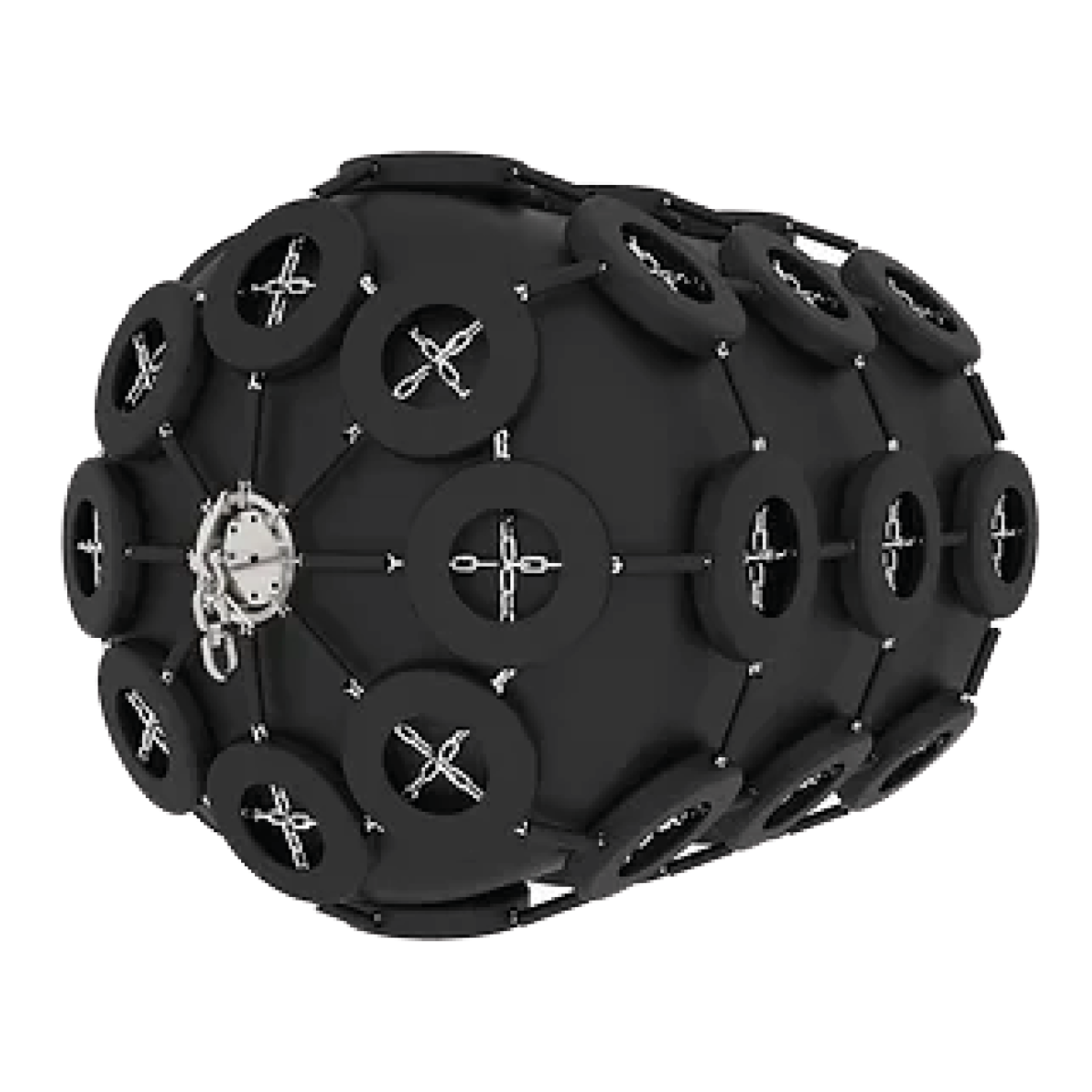
Net-type Pneumatic Fenders
Miscellaneous YOKOHAMA FENDERSPneumatic rubber fenders are commonly used for ship to ship and ship to dock berthing operation. The fender has an elliptical body which consist of inter rubber layer, a synthetic tyre-cord layer for reinforcement and outer rubber layer.
The fenders also have a tire-net outside the fender body to provide protection and better resistance to operational damage.
The best feature of pneumatic rubber fender is easy to install, easy to re-deploy. The fender is supported by the water on which it floats. It can be moored simply by means of a guy rope or chain and can be removed easily to a suitable jetty or quay when not in use, or transferred to another mooring point whenever required.
All Fender Service pneumatic fenders are produced in accordance to ISO17357-1:2014, which is the newest standard of high-pressure pneumatic fenders. ISO17357-1:2014 “Ships and marine technology - Floating pneumatic rubber fenders - Part 1: High pressure”.
This certification ensures the standard of the products, such as design, material and the performance test every fender has undergone, to ensure the overall quality of the product.
We also offer custom designed fenders, which fits every need. This includes decisions on tire-nets (aircraft/truck etc.), max inner pressure levels, and which material is preferred on chains.
All these factors affects the final performance and price of each fender.
Properties of Inner and Outer Rubber Material
All Fender Service pneumatic fenders are produced in accordance to ISO17357-1:2014, which is the newest standard of high-pressure pneumatic fenders. ISO17357-1:2014 “Ships and marine technology - Floating pneumatic rubber fenders - Part 1: High pressure”.
This certification ensures the standard of the products, such as design, material and the performance test every fender has undergone, to ensure the overall quality of the product.
|
Test item |
Testing |
Inner Rubber |
Outer Rubber |
|
| Before aging |
Tensile strength | ISO 37:2011 Type 1 |
10 Mpa or more. | 18 Mpa or more. |
| Elongation | ISO 37:2011 Type 1 |
400% or more. | 400% or more. | |
| Hardness | ISO 7619-1:2010 Type 1 |
50+/- 10 (durometer hardness test type A). | 60+/- 10 (durometer hardness test type A). | |
| After aging | Tensile strength | ISO 37:2011 Type 1 |
Not less than 80% of the original property. | Not less than 80% of the original property. |
| Elongation | ISO 37:2011 Type 1 |
Not less than 80% of the original property. | Not less than 80% of the original property. | |
| Hardness | ISO 7619-1:2010 Type A |
Not to exceed the original property by more than 8. | Not to exceed the original property by more than 8. | |
| Tear | ISO 34-1:2010 Method B |
Not applicable. | 400 N/cm or more. | |
| Compression set | ISO 815:2014 Method A |
Not applicable. | 30% (70°C +/- 1°C for 22 h) or less. | |
| Static ozone aging | ISO 1431-1:2012 | Not applicable. | No crack after elongation by 20% and exposure to 50 pphm1 at 40°C for 96 h. | |
Internal pressure 0,05 Mpa
| Nominel size | Internal pressure 0,5 KPa at 60% deflection |
Safety pressure setting |
Testing pressure | |||
| Diameter | Length | Energy absorption | Reaction force | Hull pressure | ||
| mm | mm | KN-m | KN | KPa | KPa | KPa |
| 500 | 1000 | 6 | 64 | 132 | - | 200 |
| 600 | 1000 | 8 | 74 | 126 | - | 200 |
| 700 | 1500 | 17 | 137 | 135 | - | 200 |
| 1000 | 1500 | 32 | 182 | 122 | - | 200 |
| 1000 | 2000 | 45 | 257 | 132 | - | 200 |
| 1200 | 2000 | 63 | 297 | 126 | - | 200 |
| 1350 | 2500 | 102 | 427 | 130 | - | 200 |
| 1500 | 3000 | 153 | 579 | 132 | - | 200 |
| 1700 | 3000 | 191 | 639 | 128 | - | 200 |
| 2000 | 3500 | 308 | 875 | 128 | - | 200 |
| 2500 | 4000 | 663 | 1381 | 137 | 175 | 250 |
| 2500 | 5500 | 943 | 2019 | 148 | 175 | 250 |
| 3000 | 6000 | 1309 | 2387 | 148 | 175 | 250 |
| 3300 | 4500 | 1175 | 1884 | 130 | 175 | 250 |
| 3300 | 6500 | 1814 | 3015 | 146 | 175 | 250 |
| 3300 | 10600 | 3067 | 5257 | 158 | 175 | 250 |
| 4500 | 9000 | 4752 | 5747 | 146 | 175 | 250 |
| 4500 | 12000 | 6473 | 7984 | 154 | 175 | 250 |
Internal pressure 0,08 Mpa
| Nominel size | Internal pressure 0,8 KPa at 60% deflection |
Safety pressure setting |
Testing pressure | |||
| Diameter | Length | Energy absorption | Reaction force | Hull pressure | ||
| mm | mm | KN-m | KN | KPa | KPa | KPa |
| 500 | 1000 | 8 | 85 | 174 | - | 250 |
| 600 | 1000 | 11 | 98 | 166 | - | 250 |
| 700 | 1500 | 24 | 180 | 177 | - | 250 |
| 1000 | 1500 | 45 | 239 | 160 | - | 250 |
| 1000 | 2000 | 63 | 338 | 174 | - | 250 |
| 1200 | 2000 | 88 | 390 | 166 | - | 250 |
| 1350 | 2500 | 142 | 561 | 170 | - | 250 |
| 1500 | 3000 | 214 | 761 | 174 | - | 250 |
| 1700 | 3000 | 287 | 840 | 168 | - | 250 |
| 2000 | 3500 | 430 | 1150 | 168 | - | 250 |
| 2500 | 4000 | 925 | 1815 | 180 | 230 | 300 |
| 2500 | 5500 | 1317 | 2653 | 195 | 230 | 300 |
| 3000 | 6000 | 1890 | 2906 | 196 | 230 | 300 |
| 3300 | 4500 | 1640 | 2476 | 171 | 230 | 300 |
| 3300 | 6500 | 2532 | 3961 | 191 | 230 | 300 |
| 3300 | 10600 | 4281 | 6907 | 208 | 230 | 300 |
| 4500 | 9000 | 6633 | 7551 | 192 | 230 | 300 |
| 4500 | 12000 | 9037 | 10490 | 202 | 230 | 300 |
Contact us for more info
Need assistance?
Our dedicated and skilled staff is ready to guide you towards
the right solution. Our experience onboard fishing vessels enables
us to give you hands-on advise.
Please do not hesitate to contact us.





